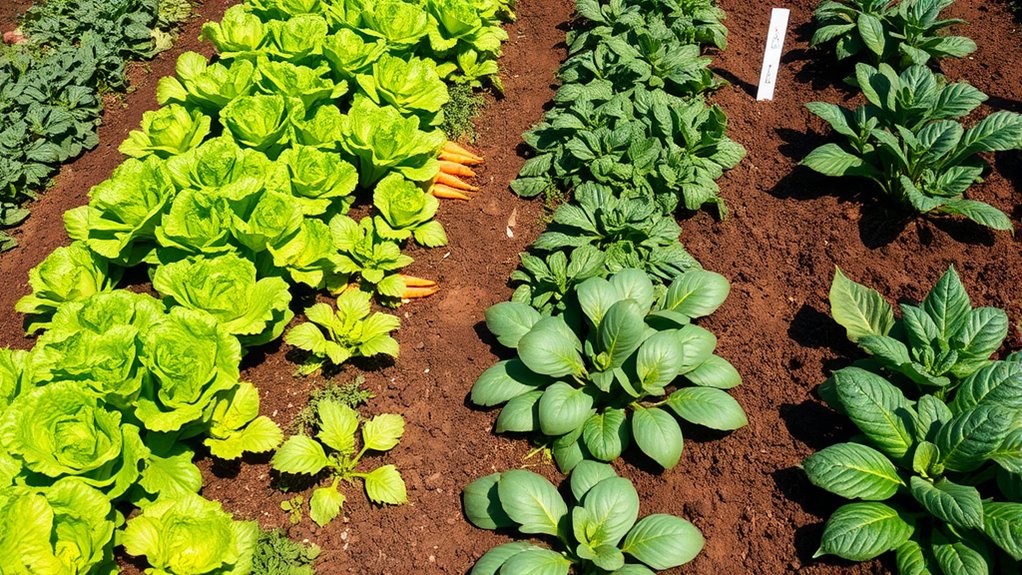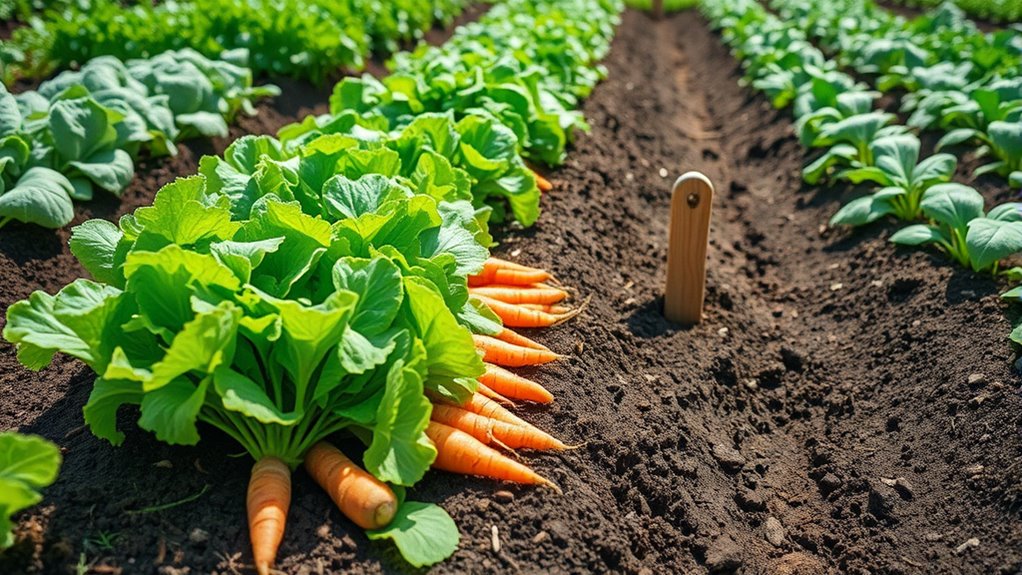Understanding crop rotation in vegetable gardens means you change plant families and crops across your garden beds each season. This helps prevent pests and diseases from becoming established and keeps soil nutrients balanced. Incorporate legumes to fix nitrogen, and grow cover crops to enrich the soil naturally. Planning and tracking your rotations guarantee healthier plants and better yields over time. Keep exploring to discover how this proven approach can transform your gardening success.
Key Takeaways
- Crop rotation involves changing plant families’ locations annually to prevent pests and diseases.
- It improves soil fertility by managing nutrient levels and incorporating cover crops or organic amendments.
- Categorizing vegetables by nutrient needs and pest susceptibility guides effective rotation planning.
- Proper record-keeping helps track crop placement and rotation effectiveness over time.
- Implementing crop rotation leads to healthier plants, higher yields, and a more sustainable garden.

Crop rotation is an essential practice that helps maintain healthy, productive vegetable gardens. By changing the crops you plant in each bed from season to season, you prevent the buildup of pests and diseases that target specific plants. This strategy also improves soil fertility by managing nutrient levels more effectively. When you rotate crops, you give the soil time to recover, reducing the risk of nutrient depletion and minimizing the need for chemical fertilizers. This practice promotes a sustainable gardening approach, making your garden more resilient and productive over time.
Crop rotation keeps your garden healthy, productive, and pest-free by managing soil nutrients and preventing disease buildup.
To start, it’s helpful to understand the basic principles of crop rotation. You should categorize your vegetables into groups based on their nutrient needs and susceptibility to pests and diseases. For example, legumes like beans and peas fix nitrogen in the soil, so they can be followed by nitrogen-hungry plants like tomatoes or peppers. Leafy greens such as lettuce or spinach typically don’t deplete many nutrients, so they can be rotated with a variety of other crops without impacting soil health considerably. Root vegetables like carrots and beets often require loose soil and are less prone to certain pests, making them suitable for rotation with above-ground crops.
Planning your crop rotation involves creating a schedule that moves plant families through different sections of your garden each year. You might assign specific plots for legumes one year, then switch to brassicas like broccoli or cabbage, followed by fruiting plants like tomatoes or cucumbers. This cycle ensures that pests specific to one group don’t become established and that soil nutrients are balanced. Keep detailed records of what you plant where, so you can track the effectiveness of your rotation plan and make adjustments as needed.
Another key point is to consider cover crops or green manure to supplement your crop rotation. These plants, like clover or vetch, are grown specifically to enrich the soil with organic matter and nutrients. They can be planted during off-season periods or integrated into your rotation schedule to boost soil health. Incorporating compost or organic amendments between rotations also enhances soil structure and fertility, creating a better environment for your vegetables. Additionally, understanding the importance of soil health fosters a more holistic and sustainable approach to your gardening practices.
In essence, crop rotation isn’t just about changing plants; it’s a strategic approach to gardening that protects your soil, reduces pests, and boosts crop yields. When you plan carefully and stick to a rotation schedule, you’ll notice healthier plants, fewer problems with pests and diseases, and a more sustainable garden that requires fewer chemical inputs. Ultimately, understanding and applying crop rotation will make your vegetable gardening experience more rewarding and environmentally friendly.
Frequently Asked Questions
How Often Should I Change Crop Families in My Garden?
You should change crop families in your garden every one to two years to prevent soil depletion and reduce pests. Rotating crops helps preserve soil health and minimizes disease buildup. If you plant the same family consecutively, you risk exhausting nutrients and encouraging pests. Planning your garden with a rotation schedule ensures your plants stay healthy, productive, and resistant to problems, making your garden more sustainable and fruitful over time.
Can Crop Rotation Prevent All Pest Infestations?
Crop rotation can’t prevent all pest infestations, but it’s a highly effective tool. By changing crop families each season, you disrupt pests’ life cycles and reduce their chances of thriving. However, pests can still find their way in through other means like nearby fields or overwintering. So, while rotation helps, you should also practice good garden hygiene, monitor regularly, and use integrated pest management strategies to keep pests under control.
What Are the Best Companion Plants for Crop Rotation?
When considering the best companion plants for crop rotation, you should focus on those that naturally deter pests and improve soil health. Marigolds repel nematodes, basil keeps away flies, and beans fix nitrogen in the soil, benefiting other crops. By planting these companions, you enhance your garden’s resilience, reduce pests, and maintain healthy soil, making your crop rotation more effective and productive.
How Do I Plan Crop Rotation for a Small Garden?
To plan crop rotation in your small garden, start by dividing your space into sections, grouping plants by family. Each season, rotate crops to a different section, avoiding planting the same family consecutively. Keep a simple chart to track what you plant where. This helps prevent pests, improves soil health, and boosts yields. Adjust your plan based on your garden’s success, and enjoy healthier plants all year round.
Are There Specific Tools to Help Track Crop Rotation Schedules?
You might wonder if there are tools to help track your crop rotation schedules. Yes, there are! You can use garden planning apps like Veggie Garden Planner or GrowVeg, which let you schedule and visualize your crop rotations. Alternatively, simple tools like spreadsheets or gardening notebooks work well. These tools help you stay organized, avoid planting the same family in the same spot, and guarantee healthy, productive gardens.
Conclusion
By rotating your crops, you’re weaving a vibrant tapestry of health and vigor in your garden. Think of it as a dance where each plant takes its turn, ensuring the soil stays nourished and pests stay at bay. Embrace the rhythm of crop rotation, and watch your vegetables flourish like a well-orchestrated symphony. With this simple step, your garden becomes a thriving masterpiece that grows stronger with every season.









